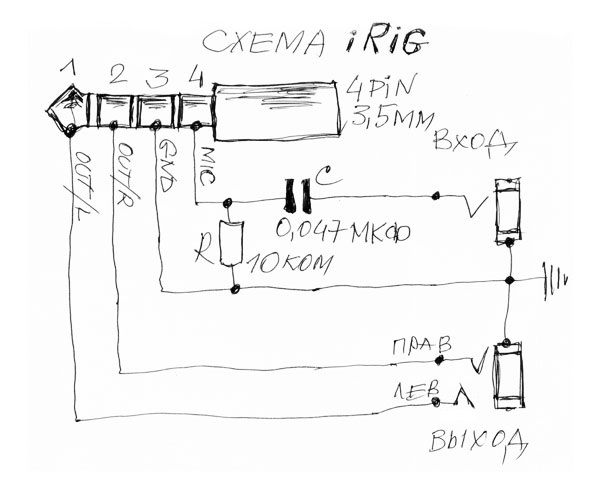Universal iRig for iPhone and Android do-it-yourself or save 30 euros
Happy owners of iPhones, most likely heard about such a thing as iRig, which, along with software from IK Multimedia (the same authors of AmpliTube - software guitar combo with pedals for PC) allow their apple technique to be used as a guitar processor. However, the prices for the official iRig are somewhat too high, to say the least. Plus, for me, a huge disadvantage of this thing was the lack of support for Android devices (read on the reasons for incompatibility).

And so, if you want to make your iRig, so that it also supports the android, plus spend the least money, then welcome under cat.
')
I work as a simple programmer in one office engaged in MG communications and Sip telephony. When developing clients for our Sip telephony, it was necessary to test the quality of communication, how different codecs work, etc. There are not many systems that are sharpened just for this, but their cost is unrealistically overpriced, apparently this is due to weak competition. Therefore, a colleague approached me with the idea of connecting the phone to a computer, and not just like that, but so that the computer was defined as a headset. Armed with Google, I climbed to read the documentation on the iPhone, in parallel went to irig (I do not have an iPhone and heard about the irig for the first time). The docks told that the iPhone, like other phones, used Jack 3.5mm with 4 segments to connect the headset. The first two are used for headphones, 3 and 4 power and ground. But then the fun began.
The fact is that with iphone (and other apple products), the order of the earth and food differs from those used on androids.
On an iPhone, it looks like this:

On Android 3 and 4, the segments (if counted from top to bottom) are rearranged. Therefore, it is necessary to make an analogue of iRig, but only universal, not only under an apple.
iRig is a plastic cylinder with a wire for connecting to an iphone / ipod / ipad, a headphone jack (and generally for sound output), an input for a guitar. With its simplicity, it allows you to make a guitar processor out of an apple device, and of quite good quality! Video as proof:
Unfortunately, the amplitube is only for apple devices, for android while in development, the problem is with delay. On an apple it is about 10ms, which is enough for comfortable playing the guitar, and under Android 100-500ms delay, it is impossible to play. IK Multimedia themselves wrote about this. And it's sad, because I want to drive it on the android, and the number of pedals scatter the eyes, that's just part of it:

For the iPhone, the circuit diagram looked like this:

But it had to be done:
1) Universal (ability to use on android)
2) Practical (some kind of box, box)
It is clear that I, as a person in radio electronics at the level of an amateur, would have been able to repeat such a corps like this:

However, creativity and desire to help a colleague did their job.
I spread a small handkerchief (you can download it at the end of the article), it looks like this (please note that everything is connected via wires, and not onto the board itself, so I made soldering points specifically for wires and not elements):

Here the numbers are marked:
1) 4 holes, where 4 core wire is soldered with 4 segment Jack 3.5mm (dad)
2) 3 wires are wired, which go to the headphone output (Jack 3.5mm mom)
3) 3 wires are soldered here that go to the input (microphone), considering that the input on the phone is mono - the left and right channels are combined into one
4) A simple variable resistor for 100 Ohms, the volume control of the incoming signal (in case the computer gets too strong a signal, that is, too loud, just for convenience)
5) There is a jumper between 2 holes
6.1-6.2) 6 wires are soldered here, connected to a shift switch with 6 legs, although in fact I used only 4 legs in the second version, I soldered 2 wires on the foot at once crosswise. But the original connection in the picture below:

Green lines - main entrance
Blue lines - android mode
Yellow lines - iPhone mode
List of used:
1) Fee 40 rubles (actually less, because I used only 1/4 of it)
2) Ingredients for weed after LUT (I used peroxide with citric acid)
3) Resistor 10kOhm cmd - 1 rub
4) Condenser - 1 rub
5) Shift switch - was available
6) Variable resistor - was available (as well as 10 rubles)
7) The case - a jar - was available, but I think 10 rubles worth it.
Those. In general, not counting peroxide and citric acid, I got 52 rubles (the maximum is 100 rubles) and 1 hour of time, instead of 30 euros. The sound quality is almost the same (by ear, I did not particularly notice).
In the first version of my improvised iriga, I used a creative jar. This is a collection collection jar, the choice was due to the fact that it was only at hand, and the form resembles the original irig.

The photo does not show the shift switch, it is on the reverse side relative to the camera position.
Also in the photo there is no red lid, it did not hit the frame (the wire passed through it).
Unfortunately, and perhaps fortunately, this hand-made article at work has gained popularity, having made several versions, they are now walking the hands of employees for non-work purposes and now it is impossible to find it in order to photograph a modified version. :)
I recommend: rub the jar with a small sandpaper, then it will become matte, the class looks altogether :)
Well, actually link:
Scheme for SprintLayout

And so, if you want to make your iRig, so that it also supports the android, plus spend the least money, then welcome under cat.
')
Entry (idea birth)
I work as a simple programmer in one office engaged in MG communications and Sip telephony. When developing clients for our Sip telephony, it was necessary to test the quality of communication, how different codecs work, etc. There are not many systems that are sharpened just for this, but their cost is unrealistically overpriced, apparently this is due to weak competition. Therefore, a colleague approached me with the idea of connecting the phone to a computer, and not just like that, but so that the computer was defined as a headset. Armed with Google, I climbed to read the documentation on the iPhone, in parallel went to irig (I do not have an iPhone and heard about the irig for the first time). The docks told that the iPhone, like other phones, used Jack 3.5mm with 4 segments to connect the headset. The first two are used for headphones, 3 and 4 power and ground. But then the fun began.
The fact is that with iphone (and other apple products), the order of the earth and food differs from those used on androids.
On an iPhone, it looks like this:

On Android 3 and 4, the segments (if counted from top to bottom) are rearranged. Therefore, it is necessary to make an analogue of iRig, but only universal, not only under an apple.
A bit about iRig
iRig is a plastic cylinder with a wire for connecting to an iphone / ipod / ipad, a headphone jack (and generally for sound output), an input for a guitar. With its simplicity, it allows you to make a guitar processor out of an apple device, and of quite good quality! Video as proof:
Unfortunately, the amplitube is only for apple devices, for android while in development, the problem is with delay. On an apple it is about 10ms, which is enough for comfortable playing the guitar, and under Android 100-500ms delay, it is impossible to play. IK Multimedia themselves wrote about this. And it's sad, because I want to drive it on the android, and the number of pedals scatter the eyes, that's just part of it:

Schemes such schemes
For the iPhone, the circuit diagram looked like this:

But it had to be done:
1) Universal (ability to use on android)
2) Practical (some kind of box, box)
It is clear that I, as a person in radio electronics at the level of an amateur, would have been able to repeat such a corps like this:

However, creativity and desire to help a colleague did their job.
I spread a small handkerchief (you can download it at the end of the article), it looks like this (please note that everything is connected via wires, and not onto the board itself, so I made soldering points specifically for wires and not elements):

Here the numbers are marked:
1) 4 holes, where 4 core wire is soldered with 4 segment Jack 3.5mm (dad)
2) 3 wires are wired, which go to the headphone output (Jack 3.5mm mom)
3) 3 wires are soldered here that go to the input (microphone), considering that the input on the phone is mono - the left and right channels are combined into one
4) A simple variable resistor for 100 Ohms, the volume control of the incoming signal (in case the computer gets too strong a signal, that is, too loud, just for convenience)
5) There is a jumper between 2 holes
6.1-6.2) 6 wires are soldered here, connected to a shift switch with 6 legs, although in fact I used only 4 legs in the second version, I soldered 2 wires on the foot at once crosswise. But the original connection in the picture below:

Green lines - main entrance
Blue lines - android mode
Yellow lines - iPhone mode
Total
List of used:
1) Fee 40 rubles (actually less, because I used only 1/4 of it)
2) Ingredients for weed after LUT (I used peroxide with citric acid)
3) Resistor 10kOhm cmd - 1 rub
4) Condenser - 1 rub
5) Shift switch - was available
6) Variable resistor - was available (as well as 10 rubles)
7) The case - a jar - was available, but I think 10 rubles worth it.
Those. In general, not counting peroxide and citric acid, I got 52 rubles (the maximum is 100 rubles) and 1 hour of time, instead of 30 euros. The sound quality is almost the same (by ear, I did not particularly notice).
In the first version of my improvised iriga, I used a creative jar. This is a collection collection jar, the choice was due to the fact that it was only at hand, and the form resembles the original irig.

The photo does not show the shift switch, it is on the reverse side relative to the camera position.
Also in the photo there is no red lid, it did not hit the frame (the wire passed through it).
Unfortunately, and perhaps fortunately, this hand-made article at work has gained popularity, having made several versions, they are now walking the hands of employees for non-work purposes and now it is impossible to find it in order to photograph a modified version. :)
I recommend: rub the jar with a small sandpaper, then it will become matte, the class looks altogether :)
Well, actually link:
Scheme for SprintLayout
Source: https://habr.com/ru/post/186456/
All Articles